Exploring the Intersection of Social Work and the Arts
VerifiedAdded on 2020/01/07
|14
|3028
|265
Essay
AI Summary
This essay examines the integration of arts, particularly drama therapy, into social work practice. It begins by establishing the core principles of social work and how creative outlets can enhance client well-being. The essay explores various artistic movements and their application in social work, emphasizing the role of art as a therapeutic tool. It highlights the limitations of traditional talk therapies and how art can facilitate emotional expression. The essay then delves into specific art forms like drama, detailing how they are used to address emotional issues, foster communication, and promote healing. It discusses the benefits of drama therapy, its applications in different settings, and its role in helping clients explore their feelings and develop coping mechanisms. The essay also references the historical context of arts in social work and the diverse modalities used to improve the physical, psychosocial, and cognitive welfare of individuals. Overall, the essay underscores the importance of creative approaches in social work to enhance client outcomes and promote a more holistic approach to care.
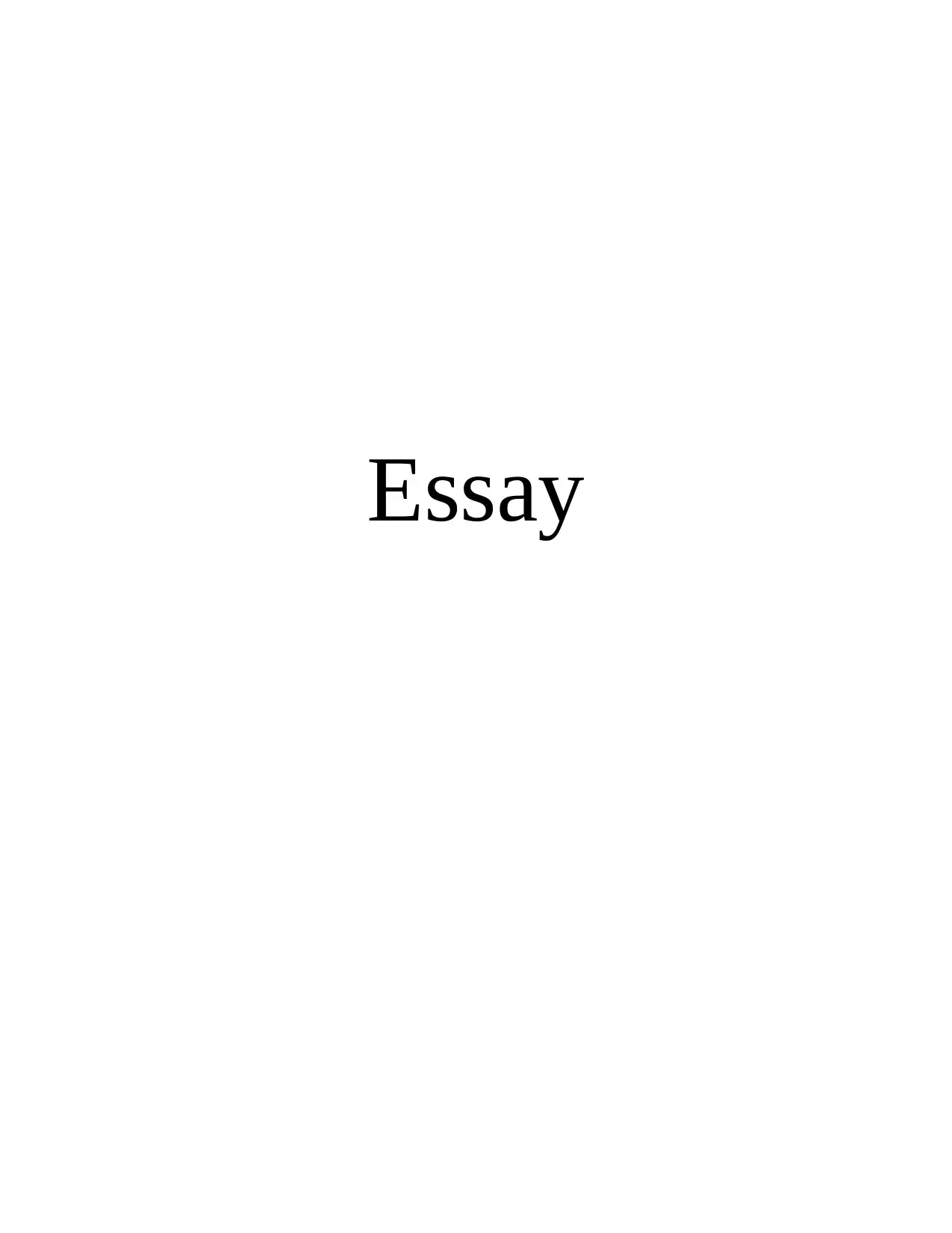
Essay
Paraphrase This Document
Need a fresh take? Get an instant paraphrase of this document with our AI Paraphraser

TABLE OF CONTENT
Social Work and the Arts............................................................................................................3
REFERENCES................................................................................................................................8
Social Work and the Arts............................................................................................................3
REFERENCES................................................................................................................................8
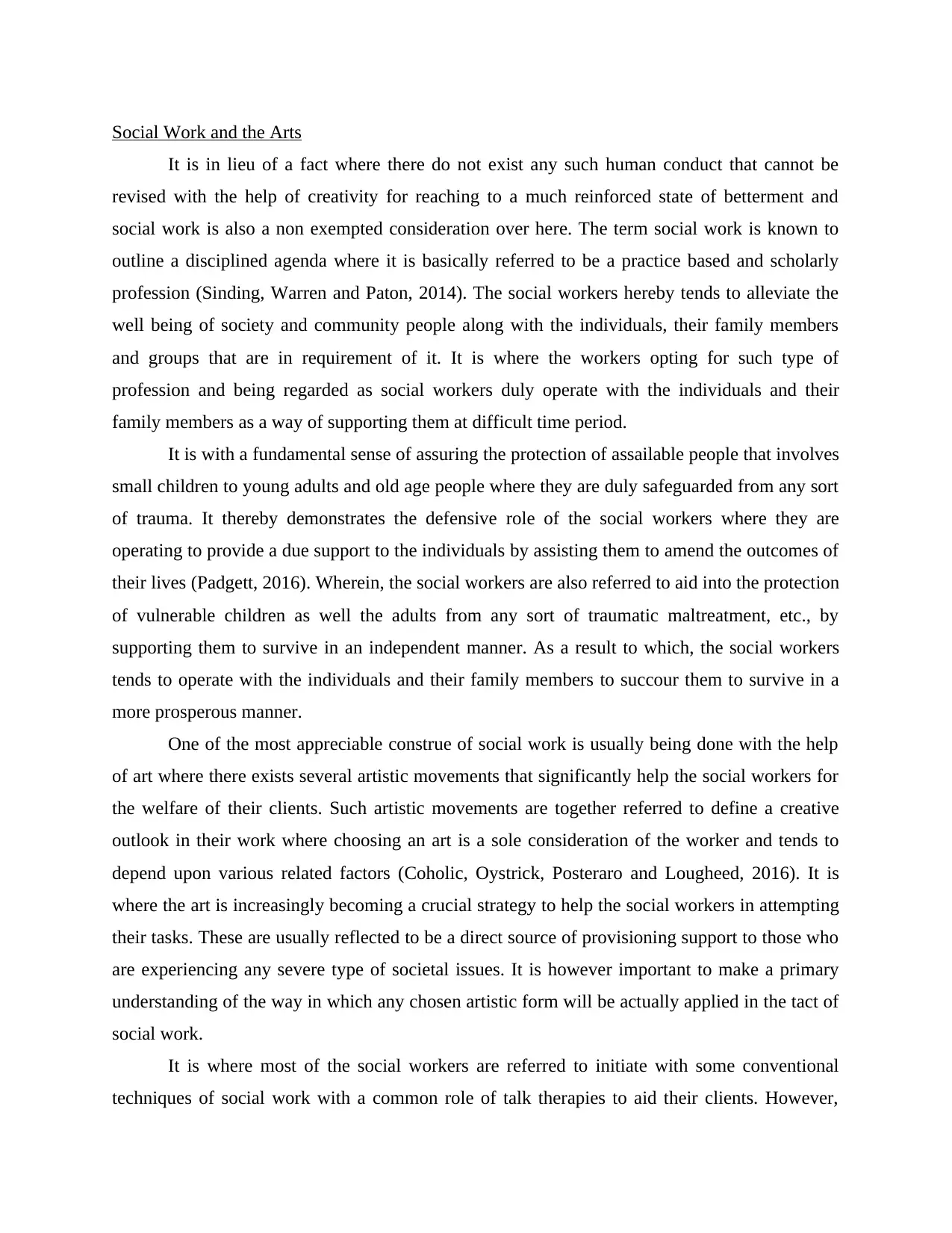
Social Work and the Arts
It is in lieu of a fact where there do not exist any such human conduct that cannot be
revised with the help of creativity for reaching to a much reinforced state of betterment and
social work is also a non exempted consideration over here. The term social work is known to
outline a disciplined agenda where it is basically referred to be a practice based and scholarly
profession (Sinding, Warren and Paton, 2014). The social workers hereby tends to alleviate the
well being of society and community people along with the individuals, their family members
and groups that are in requirement of it. It is where the workers opting for such type of
profession and being regarded as social workers duly operate with the individuals and their
family members as a way of supporting them at difficult time period.
It is with a fundamental sense of assuring the protection of assailable people that involves
small children to young adults and old age people where they are duly safeguarded from any sort
of trauma. It thereby demonstrates the defensive role of the social workers where they are
operating to provide a due support to the individuals by assisting them to amend the outcomes of
their lives (Padgett, 2016). Wherein, the social workers are also referred to aid into the protection
of vulnerable children as well the adults from any sort of traumatic maltreatment, etc., by
supporting them to survive in an independent manner. As a result to which, the social workers
tends to operate with the individuals and their family members to succour them to survive in a
more prosperous manner.
One of the most appreciable construe of social work is usually being done with the help
of art where there exists several artistic movements that significantly help the social workers for
the welfare of their clients. Such artistic movements are together referred to define a creative
outlook in their work where choosing an art is a sole consideration of the worker and tends to
depend upon various related factors (Coholic, Oystrick, Posteraro and Lougheed, 2016). It is
where the art is increasingly becoming a crucial strategy to help the social workers in attempting
their tasks. These are usually reflected to be a direct source of provisioning support to those who
are experiencing any severe type of societal issues. It is however important to make a primary
understanding of the way in which any chosen artistic form will be actually applied in the tact of
social work.
It is where most of the social workers are referred to initiate with some conventional
techniques of social work with a common role of talk therapies to aid their clients. However,
It is in lieu of a fact where there do not exist any such human conduct that cannot be
revised with the help of creativity for reaching to a much reinforced state of betterment and
social work is also a non exempted consideration over here. The term social work is known to
outline a disciplined agenda where it is basically referred to be a practice based and scholarly
profession (Sinding, Warren and Paton, 2014). The social workers hereby tends to alleviate the
well being of society and community people along with the individuals, their family members
and groups that are in requirement of it. It is where the workers opting for such type of
profession and being regarded as social workers duly operate with the individuals and their
family members as a way of supporting them at difficult time period.
It is with a fundamental sense of assuring the protection of assailable people that involves
small children to young adults and old age people where they are duly safeguarded from any sort
of trauma. It thereby demonstrates the defensive role of the social workers where they are
operating to provide a due support to the individuals by assisting them to amend the outcomes of
their lives (Padgett, 2016). Wherein, the social workers are also referred to aid into the protection
of vulnerable children as well the adults from any sort of traumatic maltreatment, etc., by
supporting them to survive in an independent manner. As a result to which, the social workers
tends to operate with the individuals and their family members to succour them to survive in a
more prosperous manner.
One of the most appreciable construe of social work is usually being done with the help
of art where there exists several artistic movements that significantly help the social workers for
the welfare of their clients. Such artistic movements are together referred to define a creative
outlook in their work where choosing an art is a sole consideration of the worker and tends to
depend upon various related factors (Coholic, Oystrick, Posteraro and Lougheed, 2016). It is
where the art is increasingly becoming a crucial strategy to help the social workers in attempting
their tasks. These are usually reflected to be a direct source of provisioning support to those who
are experiencing any severe type of societal issues. It is however important to make a primary
understanding of the way in which any chosen artistic form will be actually applied in the tact of
social work.
It is where most of the social workers are referred to initiate with some conventional
techniques of social work with a common role of talk therapies to aid their clients. However,
⊘ This is a preview!⊘
Do you want full access?
Subscribe today to unlock all pages.

Trusted by 1+ million students worldwide
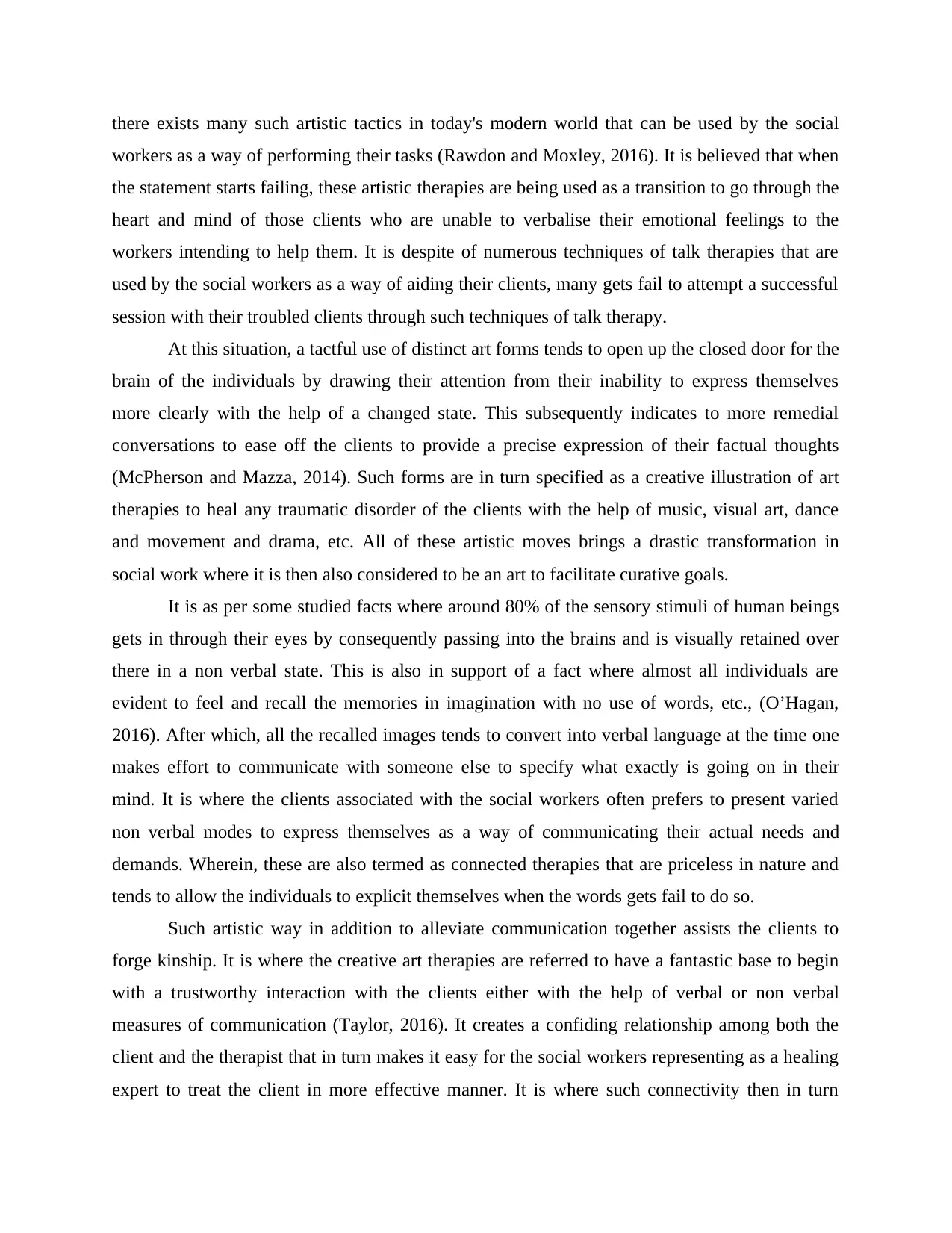
there exists many such artistic tactics in today's modern world that can be used by the social
workers as a way of performing their tasks (Rawdon and Moxley, 2016). It is believed that when
the statement starts failing, these artistic therapies are being used as a transition to go through the
heart and mind of those clients who are unable to verbalise their emotional feelings to the
workers intending to help them. It is despite of numerous techniques of talk therapies that are
used by the social workers as a way of aiding their clients, many gets fail to attempt a successful
session with their troubled clients through such techniques of talk therapy.
At this situation, a tactful use of distinct art forms tends to open up the closed door for the
brain of the individuals by drawing their attention from their inability to express themselves
more clearly with the help of a changed state. This subsequently indicates to more remedial
conversations to ease off the clients to provide a precise expression of their factual thoughts
(McPherson and Mazza, 2014). Such forms are in turn specified as a creative illustration of art
therapies to heal any traumatic disorder of the clients with the help of music, visual art, dance
and movement and drama, etc. All of these artistic moves brings a drastic transformation in
social work where it is then also considered to be an art to facilitate curative goals.
It is as per some studied facts where around 80% of the sensory stimuli of human beings
gets in through their eyes by consequently passing into the brains and is visually retained over
there in a non verbal state. This is also in support of a fact where almost all individuals are
evident to feel and recall the memories in imagination with no use of words, etc., (O’Hagan,
2016). After which, all the recalled images tends to convert into verbal language at the time one
makes effort to communicate with someone else to specify what exactly is going on in their
mind. It is where the clients associated with the social workers often prefers to present varied
non verbal modes to express themselves as a way of communicating their actual needs and
demands. Wherein, these are also termed as connected therapies that are priceless in nature and
tends to allow the individuals to explicit themselves when the words gets fail to do so.
Such artistic way in addition to alleviate communication together assists the clients to
forge kinship. It is where the creative art therapies are referred to have a fantastic base to begin
with a trustworthy interaction with the clients either with the help of verbal or non verbal
measures of communication (Taylor, 2016). It creates a confiding relationship among both the
client and the therapist that in turn makes it easy for the social workers representing as a healing
expert to treat the client in more effective manner. It is where such connectivity then in turn
workers as a way of performing their tasks (Rawdon and Moxley, 2016). It is believed that when
the statement starts failing, these artistic therapies are being used as a transition to go through the
heart and mind of those clients who are unable to verbalise their emotional feelings to the
workers intending to help them. It is despite of numerous techniques of talk therapies that are
used by the social workers as a way of aiding their clients, many gets fail to attempt a successful
session with their troubled clients through such techniques of talk therapy.
At this situation, a tactful use of distinct art forms tends to open up the closed door for the
brain of the individuals by drawing their attention from their inability to express themselves
more clearly with the help of a changed state. This subsequently indicates to more remedial
conversations to ease off the clients to provide a precise expression of their factual thoughts
(McPherson and Mazza, 2014). Such forms are in turn specified as a creative illustration of art
therapies to heal any traumatic disorder of the clients with the help of music, visual art, dance
and movement and drama, etc. All of these artistic moves brings a drastic transformation in
social work where it is then also considered to be an art to facilitate curative goals.
It is as per some studied facts where around 80% of the sensory stimuli of human beings
gets in through their eyes by consequently passing into the brains and is visually retained over
there in a non verbal state. This is also in support of a fact where almost all individuals are
evident to feel and recall the memories in imagination with no use of words, etc., (O’Hagan,
2016). After which, all the recalled images tends to convert into verbal language at the time one
makes effort to communicate with someone else to specify what exactly is going on in their
mind. It is where the clients associated with the social workers often prefers to present varied
non verbal modes to express themselves as a way of communicating their actual needs and
demands. Wherein, these are also termed as connected therapies that are priceless in nature and
tends to allow the individuals to explicit themselves when the words gets fail to do so.
Such artistic way in addition to alleviate communication together assists the clients to
forge kinship. It is where the creative art therapies are referred to have a fantastic base to begin
with a trustworthy interaction with the clients either with the help of verbal or non verbal
measures of communication (Taylor, 2016). It creates a confiding relationship among both the
client and the therapist that in turn makes it easy for the social workers representing as a healing
expert to treat the client in more effective manner. It is where such connectivity then in turn
Paraphrase This Document
Need a fresh take? Get an instant paraphrase of this document with our AI Paraphraser
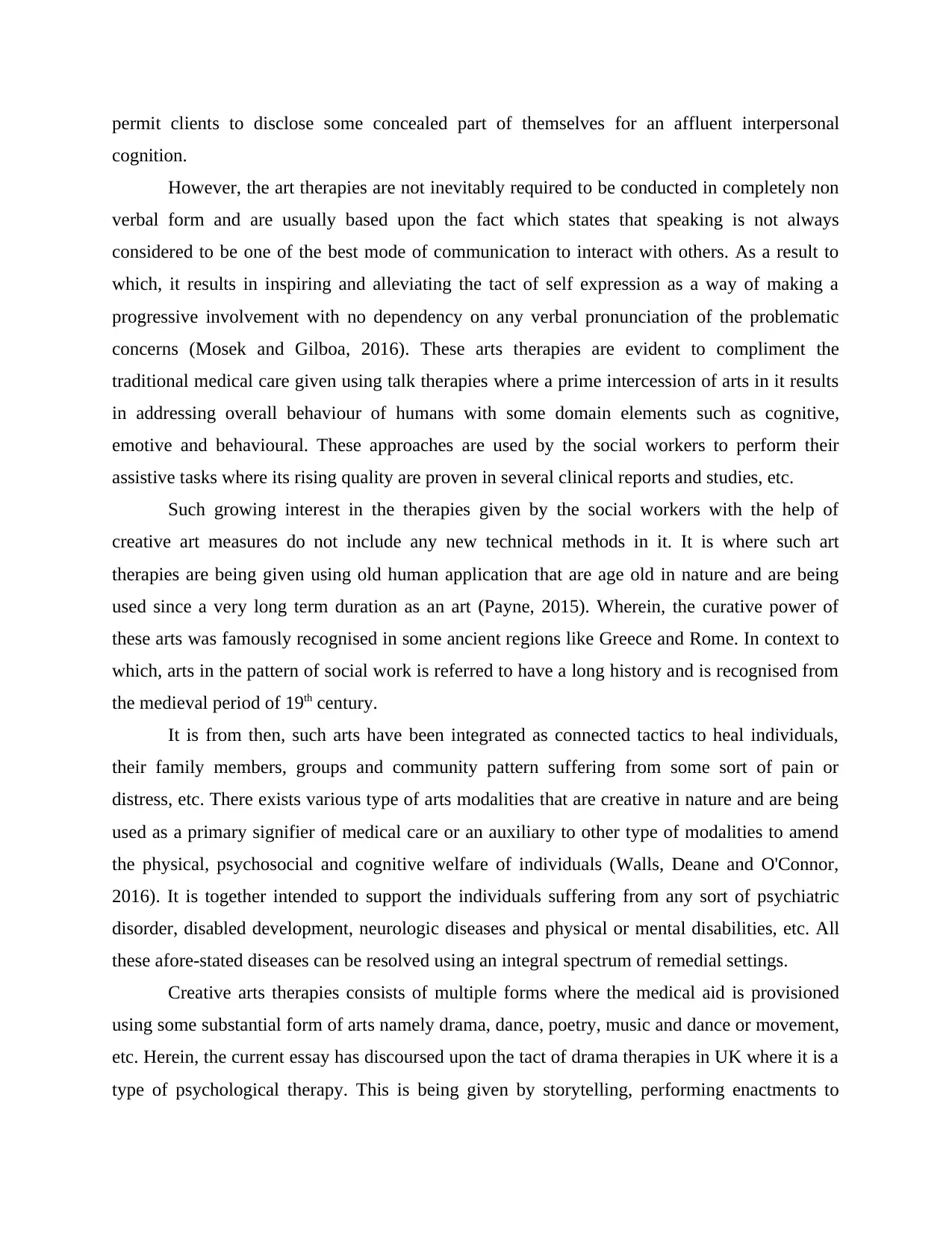
permit clients to disclose some concealed part of themselves for an affluent interpersonal
cognition.
However, the art therapies are not inevitably required to be conducted in completely non
verbal form and are usually based upon the fact which states that speaking is not always
considered to be one of the best mode of communication to interact with others. As a result to
which, it results in inspiring and alleviating the tact of self expression as a way of making a
progressive involvement with no dependency on any verbal pronunciation of the problematic
concerns (Mosek and Gilboa, 2016). These arts therapies are evident to compliment the
traditional medical care given using talk therapies where a prime intercession of arts in it results
in addressing overall behaviour of humans with some domain elements such as cognitive,
emotive and behavioural. These approaches are used by the social workers to perform their
assistive tasks where its rising quality are proven in several clinical reports and studies, etc.
Such growing interest in the therapies given by the social workers with the help of
creative art measures do not include any new technical methods in it. It is where such art
therapies are being given using old human application that are age old in nature and are being
used since a very long term duration as an art (Payne, 2015). Wherein, the curative power of
these arts was famously recognised in some ancient regions like Greece and Rome. In context to
which, arts in the pattern of social work is referred to have a long history and is recognised from
the medieval period of 19th century.
It is from then, such arts have been integrated as connected tactics to heal individuals,
their family members, groups and community pattern suffering from some sort of pain or
distress, etc. There exists various type of arts modalities that are creative in nature and are being
used as a primary signifier of medical care or an auxiliary to other type of modalities to amend
the physical, psychosocial and cognitive welfare of individuals (Walls, Deane and O'Connor,
2016). It is together intended to support the individuals suffering from any sort of psychiatric
disorder, disabled development, neurologic diseases and physical or mental disabilities, etc. All
these afore-stated diseases can be resolved using an integral spectrum of remedial settings.
Creative arts therapies consists of multiple forms where the medical aid is provisioned
using some substantial form of arts namely drama, dance, poetry, music and dance or movement,
etc. Herein, the current essay has discoursed upon the tact of drama therapies in UK where it is a
type of psychological therapy. This is being given by storytelling, performing enactments to
cognition.
However, the art therapies are not inevitably required to be conducted in completely non
verbal form and are usually based upon the fact which states that speaking is not always
considered to be one of the best mode of communication to interact with others. As a result to
which, it results in inspiring and alleviating the tact of self expression as a way of making a
progressive involvement with no dependency on any verbal pronunciation of the problematic
concerns (Mosek and Gilboa, 2016). These arts therapies are evident to compliment the
traditional medical care given using talk therapies where a prime intercession of arts in it results
in addressing overall behaviour of humans with some domain elements such as cognitive,
emotive and behavioural. These approaches are used by the social workers to perform their
assistive tasks where its rising quality are proven in several clinical reports and studies, etc.
Such growing interest in the therapies given by the social workers with the help of
creative art measures do not include any new technical methods in it. It is where such art
therapies are being given using old human application that are age old in nature and are being
used since a very long term duration as an art (Payne, 2015). Wherein, the curative power of
these arts was famously recognised in some ancient regions like Greece and Rome. In context to
which, arts in the pattern of social work is referred to have a long history and is recognised from
the medieval period of 19th century.
It is from then, such arts have been integrated as connected tactics to heal individuals,
their family members, groups and community pattern suffering from some sort of pain or
distress, etc. There exists various type of arts modalities that are creative in nature and are being
used as a primary signifier of medical care or an auxiliary to other type of modalities to amend
the physical, psychosocial and cognitive welfare of individuals (Walls, Deane and O'Connor,
2016). It is together intended to support the individuals suffering from any sort of psychiatric
disorder, disabled development, neurologic diseases and physical or mental disabilities, etc. All
these afore-stated diseases can be resolved using an integral spectrum of remedial settings.
Creative arts therapies consists of multiple forms where the medical aid is provisioned
using some substantial form of arts namely drama, dance, poetry, music and dance or movement,
etc. Herein, the current essay has discoursed upon the tact of drama therapies in UK where it is a
type of psychological therapy. This is being given by storytelling, performing enactments to
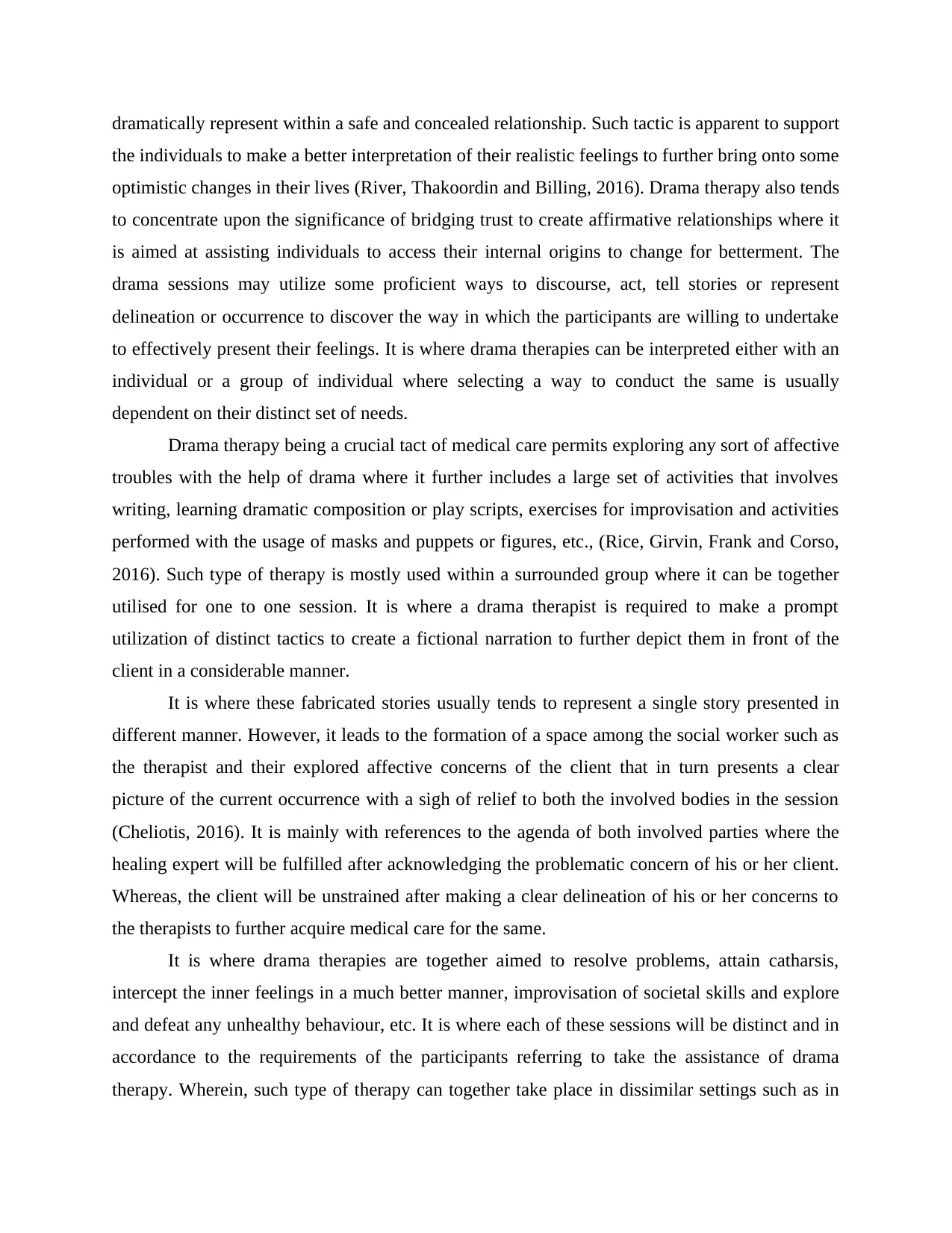
dramatically represent within a safe and concealed relationship. Such tactic is apparent to support
the individuals to make a better interpretation of their realistic feelings to further bring onto some
optimistic changes in their lives (River, Thakoordin and Billing, 2016). Drama therapy also tends
to concentrate upon the significance of bridging trust to create affirmative relationships where it
is aimed at assisting individuals to access their internal origins to change for betterment. The
drama sessions may utilize some proficient ways to discourse, act, tell stories or represent
delineation or occurrence to discover the way in which the participants are willing to undertake
to effectively present their feelings. It is where drama therapies can be interpreted either with an
individual or a group of individual where selecting a way to conduct the same is usually
dependent on their distinct set of needs.
Drama therapy being a crucial tact of medical care permits exploring any sort of affective
troubles with the help of drama where it further includes a large set of activities that involves
writing, learning dramatic composition or play scripts, exercises for improvisation and activities
performed with the usage of masks and puppets or figures, etc., (Rice, Girvin, Frank and Corso,
2016). Such type of therapy is mostly used within a surrounded group where it can be together
utilised for one to one session. It is where a drama therapist is required to make a prompt
utilization of distinct tactics to create a fictional narration to further depict them in front of the
client in a considerable manner.
It is where these fabricated stories usually tends to represent a single story presented in
different manner. However, it leads to the formation of a space among the social worker such as
the therapist and their explored affective concerns of the client that in turn presents a clear
picture of the current occurrence with a sigh of relief to both the involved bodies in the session
(Cheliotis, 2016). It is mainly with references to the agenda of both involved parties where the
healing expert will be fulfilled after acknowledging the problematic concern of his or her client.
Whereas, the client will be unstrained after making a clear delineation of his or her concerns to
the therapists to further acquire medical care for the same.
It is where drama therapies are together aimed to resolve problems, attain catharsis,
intercept the inner feelings in a much better manner, improvisation of societal skills and explore
and defeat any unhealthy behaviour, etc. It is where each of these sessions will be distinct and in
accordance to the requirements of the participants referring to take the assistance of drama
therapy. Wherein, such type of therapy can together take place in dissimilar settings such as in
the individuals to make a better interpretation of their realistic feelings to further bring onto some
optimistic changes in their lives (River, Thakoordin and Billing, 2016). Drama therapy also tends
to concentrate upon the significance of bridging trust to create affirmative relationships where it
is aimed at assisting individuals to access their internal origins to change for betterment. The
drama sessions may utilize some proficient ways to discourse, act, tell stories or represent
delineation or occurrence to discover the way in which the participants are willing to undertake
to effectively present their feelings. It is where drama therapies can be interpreted either with an
individual or a group of individual where selecting a way to conduct the same is usually
dependent on their distinct set of needs.
Drama therapy being a crucial tact of medical care permits exploring any sort of affective
troubles with the help of drama where it further includes a large set of activities that involves
writing, learning dramatic composition or play scripts, exercises for improvisation and activities
performed with the usage of masks and puppets or figures, etc., (Rice, Girvin, Frank and Corso,
2016). Such type of therapy is mostly used within a surrounded group where it can be together
utilised for one to one session. It is where a drama therapist is required to make a prompt
utilization of distinct tactics to create a fictional narration to further depict them in front of the
client in a considerable manner.
It is where these fabricated stories usually tends to represent a single story presented in
different manner. However, it leads to the formation of a space among the social worker such as
the therapist and their explored affective concerns of the client that in turn presents a clear
picture of the current occurrence with a sigh of relief to both the involved bodies in the session
(Cheliotis, 2016). It is mainly with references to the agenda of both involved parties where the
healing expert will be fulfilled after acknowledging the problematic concern of his or her client.
Whereas, the client will be unstrained after making a clear delineation of his or her concerns to
the therapists to further acquire medical care for the same.
It is where drama therapies are together aimed to resolve problems, attain catharsis,
intercept the inner feelings in a much better manner, improvisation of societal skills and explore
and defeat any unhealthy behaviour, etc. It is where each of these sessions will be distinct and in
accordance to the requirements of the participants referring to take the assistance of drama
therapy. Wherein, such type of therapy can together take place in dissimilar settings such as in
⊘ This is a preview!⊘
Do you want full access?
Subscribe today to unlock all pages.

Trusted by 1+ million students worldwide
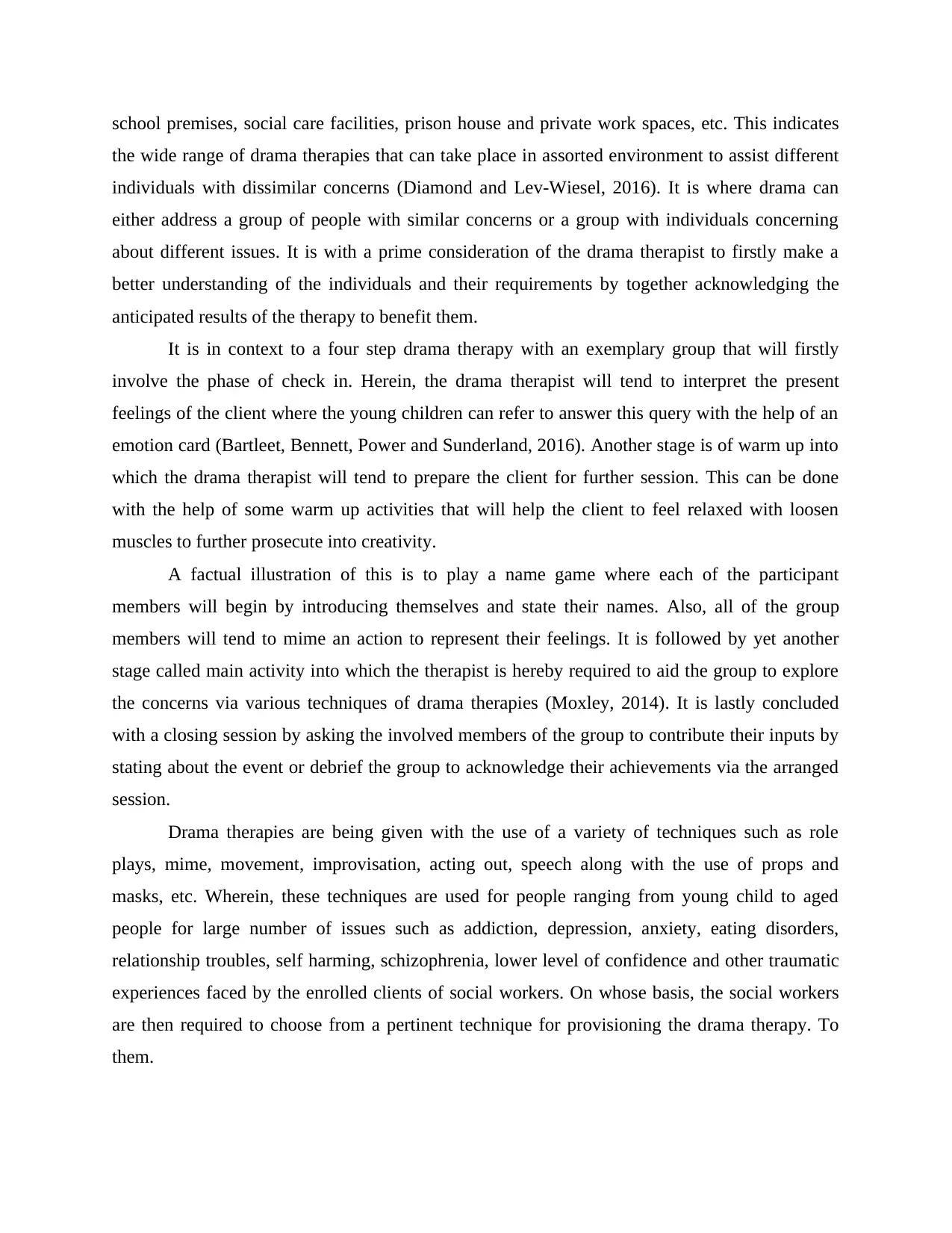
school premises, social care facilities, prison house and private work spaces, etc. This indicates
the wide range of drama therapies that can take place in assorted environment to assist different
individuals with dissimilar concerns (Diamond and Lev-Wiesel, 2016). It is where drama can
either address a group of people with similar concerns or a group with individuals concerning
about different issues. It is with a prime consideration of the drama therapist to firstly make a
better understanding of the individuals and their requirements by together acknowledging the
anticipated results of the therapy to benefit them.
It is in context to a four step drama therapy with an exemplary group that will firstly
involve the phase of check in. Herein, the drama therapist will tend to interpret the present
feelings of the client where the young children can refer to answer this query with the help of an
emotion card (Bartleet, Bennett, Power and Sunderland, 2016). Another stage is of warm up into
which the drama therapist will tend to prepare the client for further session. This can be done
with the help of some warm up activities that will help the client to feel relaxed with loosen
muscles to further prosecute into creativity.
A factual illustration of this is to play a name game where each of the participant
members will begin by introducing themselves and state their names. Also, all of the group
members will tend to mime an action to represent their feelings. It is followed by yet another
stage called main activity into which the therapist is hereby required to aid the group to explore
the concerns via various techniques of drama therapies (Moxley, 2014). It is lastly concluded
with a closing session by asking the involved members of the group to contribute their inputs by
stating about the event or debrief the group to acknowledge their achievements via the arranged
session.
Drama therapies are being given with the use of a variety of techniques such as role
plays, mime, movement, improvisation, acting out, speech along with the use of props and
masks, etc. Wherein, these techniques are used for people ranging from young child to aged
people for large number of issues such as addiction, depression, anxiety, eating disorders,
relationship troubles, self harming, schizophrenia, lower level of confidence and other traumatic
experiences faced by the enrolled clients of social workers. On whose basis, the social workers
are then required to choose from a pertinent technique for provisioning the drama therapy. To
them.
the wide range of drama therapies that can take place in assorted environment to assist different
individuals with dissimilar concerns (Diamond and Lev-Wiesel, 2016). It is where drama can
either address a group of people with similar concerns or a group with individuals concerning
about different issues. It is with a prime consideration of the drama therapist to firstly make a
better understanding of the individuals and their requirements by together acknowledging the
anticipated results of the therapy to benefit them.
It is in context to a four step drama therapy with an exemplary group that will firstly
involve the phase of check in. Herein, the drama therapist will tend to interpret the present
feelings of the client where the young children can refer to answer this query with the help of an
emotion card (Bartleet, Bennett, Power and Sunderland, 2016). Another stage is of warm up into
which the drama therapist will tend to prepare the client for further session. This can be done
with the help of some warm up activities that will help the client to feel relaxed with loosen
muscles to further prosecute into creativity.
A factual illustration of this is to play a name game where each of the participant
members will begin by introducing themselves and state their names. Also, all of the group
members will tend to mime an action to represent their feelings. It is followed by yet another
stage called main activity into which the therapist is hereby required to aid the group to explore
the concerns via various techniques of drama therapies (Moxley, 2014). It is lastly concluded
with a closing session by asking the involved members of the group to contribute their inputs by
stating about the event or debrief the group to acknowledge their achievements via the arranged
session.
Drama therapies are being given with the use of a variety of techniques such as role
plays, mime, movement, improvisation, acting out, speech along with the use of props and
masks, etc. Wherein, these techniques are used for people ranging from young child to aged
people for large number of issues such as addiction, depression, anxiety, eating disorders,
relationship troubles, self harming, schizophrenia, lower level of confidence and other traumatic
experiences faced by the enrolled clients of social workers. On whose basis, the social workers
are then required to choose from a pertinent technique for provisioning the drama therapy. To
them.
Paraphrase This Document
Need a fresh take? Get an instant paraphrase of this document with our AI Paraphraser
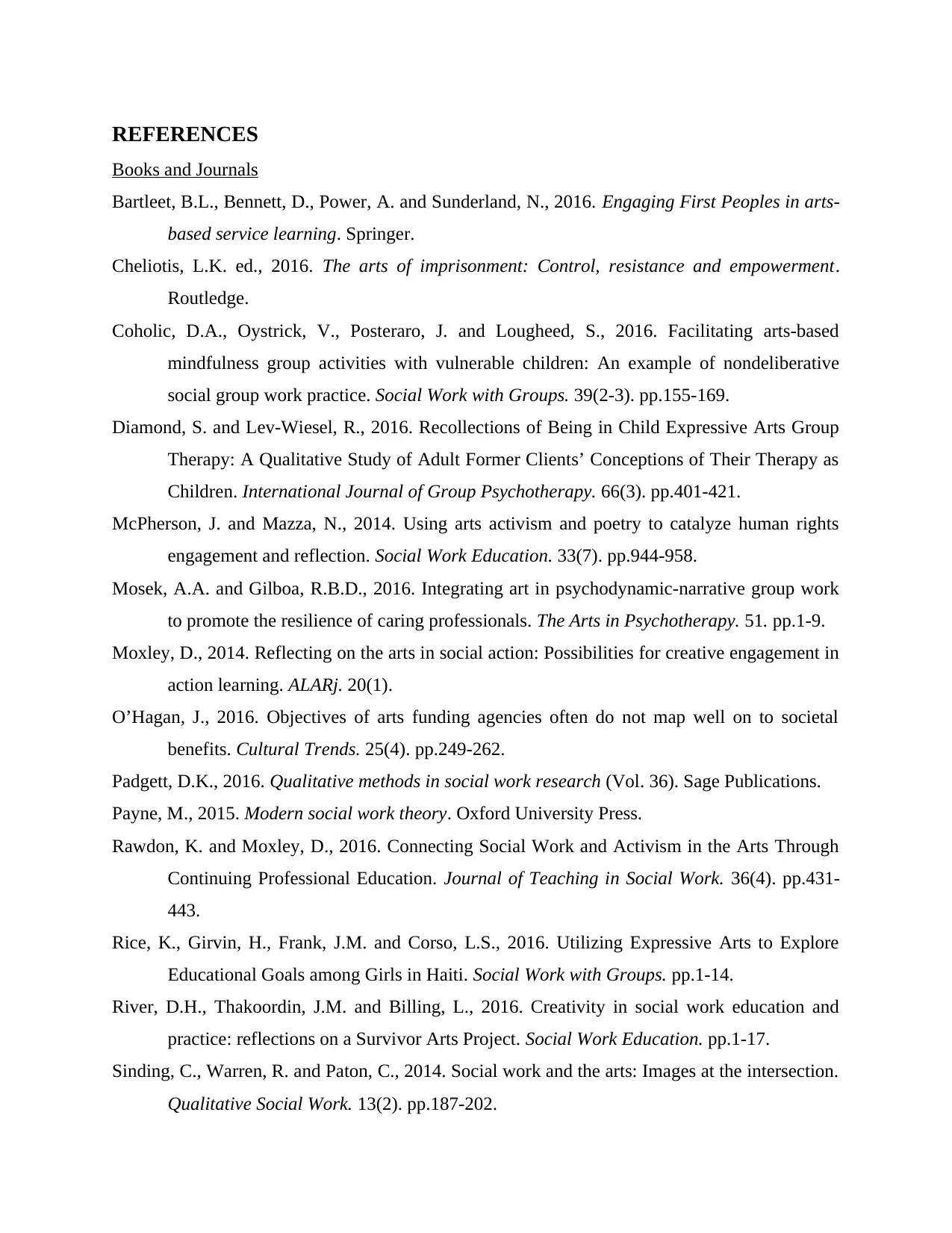
REFERENCES
Books and Journals
Bartleet, B.L., Bennett, D., Power, A. and Sunderland, N., 2016. Engaging First Peoples in arts-
based service learning. Springer.
Cheliotis, L.K. ed., 2016. The arts of imprisonment: Control, resistance and empowerment.
Routledge.
Coholic, D.A., Oystrick, V., Posteraro, J. and Lougheed, S., 2016. Facilitating arts-based
mindfulness group activities with vulnerable children: An example of nondeliberative
social group work practice. Social Work with Groups. 39(2-3). pp.155-169.
Diamond, S. and Lev-Wiesel, R., 2016. Recollections of Being in Child Expressive Arts Group
Therapy: A Qualitative Study of Adult Former Clients’ Conceptions of Their Therapy as
Children. International Journal of Group Psychotherapy. 66(3). pp.401-421.
McPherson, J. and Mazza, N., 2014. Using arts activism and poetry to catalyze human rights
engagement and reflection. Social Work Education. 33(7). pp.944-958.
Mosek, A.A. and Gilboa, R.B.D., 2016. Integrating art in psychodynamic-narrative group work
to promote the resilience of caring professionals. The Arts in Psychotherapy. 51. pp.1-9.
Moxley, D., 2014. Reflecting on the arts in social action: Possibilities for creative engagement in
action learning. ALARj. 20(1).
O’Hagan, J., 2016. Objectives of arts funding agencies often do not map well on to societal
benefits. Cultural Trends. 25(4). pp.249-262.
Padgett, D.K., 2016. Qualitative methods in social work research (Vol. 36). Sage Publications.
Payne, M., 2015. Modern social work theory. Oxford University Press.
Rawdon, K. and Moxley, D., 2016. Connecting Social Work and Activism in the Arts Through
Continuing Professional Education. Journal of Teaching in Social Work. 36(4). pp.431-
443.
Rice, K., Girvin, H., Frank, J.M. and Corso, L.S., 2016. Utilizing Expressive Arts to Explore
Educational Goals among Girls in Haiti. Social Work with Groups. pp.1-14.
River, D.H., Thakoordin, J.M. and Billing, L., 2016. Creativity in social work education and
practice: reflections on a Survivor Arts Project. Social Work Education. pp.1-17.
Sinding, C., Warren, R. and Paton, C., 2014. Social work and the arts: Images at the intersection.
Qualitative Social Work. 13(2). pp.187-202.
Books and Journals
Bartleet, B.L., Bennett, D., Power, A. and Sunderland, N., 2016. Engaging First Peoples in arts-
based service learning. Springer.
Cheliotis, L.K. ed., 2016. The arts of imprisonment: Control, resistance and empowerment.
Routledge.
Coholic, D.A., Oystrick, V., Posteraro, J. and Lougheed, S., 2016. Facilitating arts-based
mindfulness group activities with vulnerable children: An example of nondeliberative
social group work practice. Social Work with Groups. 39(2-3). pp.155-169.
Diamond, S. and Lev-Wiesel, R., 2016. Recollections of Being in Child Expressive Arts Group
Therapy: A Qualitative Study of Adult Former Clients’ Conceptions of Their Therapy as
Children. International Journal of Group Psychotherapy. 66(3). pp.401-421.
McPherson, J. and Mazza, N., 2014. Using arts activism and poetry to catalyze human rights
engagement and reflection. Social Work Education. 33(7). pp.944-958.
Mosek, A.A. and Gilboa, R.B.D., 2016. Integrating art in psychodynamic-narrative group work
to promote the resilience of caring professionals. The Arts in Psychotherapy. 51. pp.1-9.
Moxley, D., 2014. Reflecting on the arts in social action: Possibilities for creative engagement in
action learning. ALARj. 20(1).
O’Hagan, J., 2016. Objectives of arts funding agencies often do not map well on to societal
benefits. Cultural Trends. 25(4). pp.249-262.
Padgett, D.K., 2016. Qualitative methods in social work research (Vol. 36). Sage Publications.
Payne, M., 2015. Modern social work theory. Oxford University Press.
Rawdon, K. and Moxley, D., 2016. Connecting Social Work and Activism in the Arts Through
Continuing Professional Education. Journal of Teaching in Social Work. 36(4). pp.431-
443.
Rice, K., Girvin, H., Frank, J.M. and Corso, L.S., 2016. Utilizing Expressive Arts to Explore
Educational Goals among Girls in Haiti. Social Work with Groups. pp.1-14.
River, D.H., Thakoordin, J.M. and Billing, L., 2016. Creativity in social work education and
practice: reflections on a Survivor Arts Project. Social Work Education. pp.1-17.
Sinding, C., Warren, R. and Paton, C., 2014. Social work and the arts: Images at the intersection.
Qualitative Social Work. 13(2). pp.187-202.

Taylor, Y. ed., 2016. Classed intersections: Spaces, selves, knowledges. Routledge.
Walls, A., Deane, K.L. and O'Connor, P.J., 2016. ‘Looking for the blue, the yellow, all the
colours of the rainbow’: the value of participatory arts for young people in social work
practice. Aotearoa New Zealand Social Work. 28(4). pp.67-79.
Walls, A., Deane, K.L. and O'Connor, P.J., 2016. ‘Looking for the blue, the yellow, all the
colours of the rainbow’: the value of participatory arts for young people in social work
practice. Aotearoa New Zealand Social Work. 28(4). pp.67-79.
⊘ This is a preview!⊘
Do you want full access?
Subscribe today to unlock all pages.

Trusted by 1+ million students worldwide

Paraphrase This Document
Need a fresh take? Get an instant paraphrase of this document with our AI Paraphraser

1

2
⊘ This is a preview!⊘
Do you want full access?
Subscribe today to unlock all pages.

Trusted by 1+ million students worldwide
1 out of 14
Related Documents
Your All-in-One AI-Powered Toolkit for Academic Success.
+13062052269
info@desklib.com
Available 24*7 on WhatsApp / Email
![[object Object]](/_next/static/media/star-bottom.7253800d.svg)
Unlock your academic potential
Copyright © 2020–2025 A2Z Services. All Rights Reserved. Developed and managed by ZUCOL.





